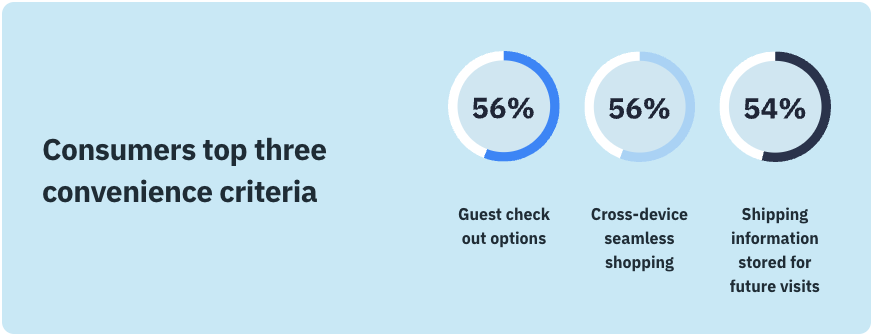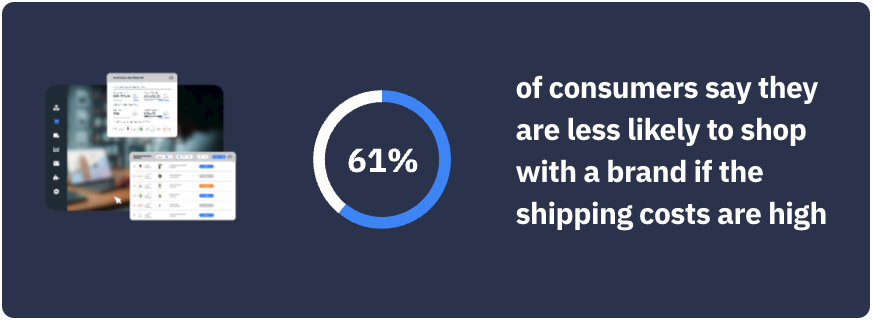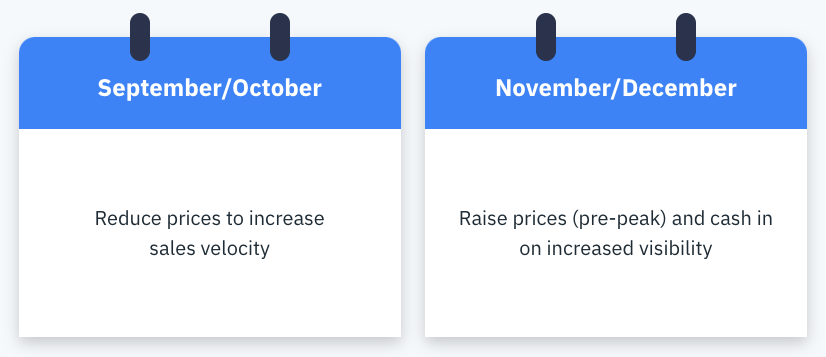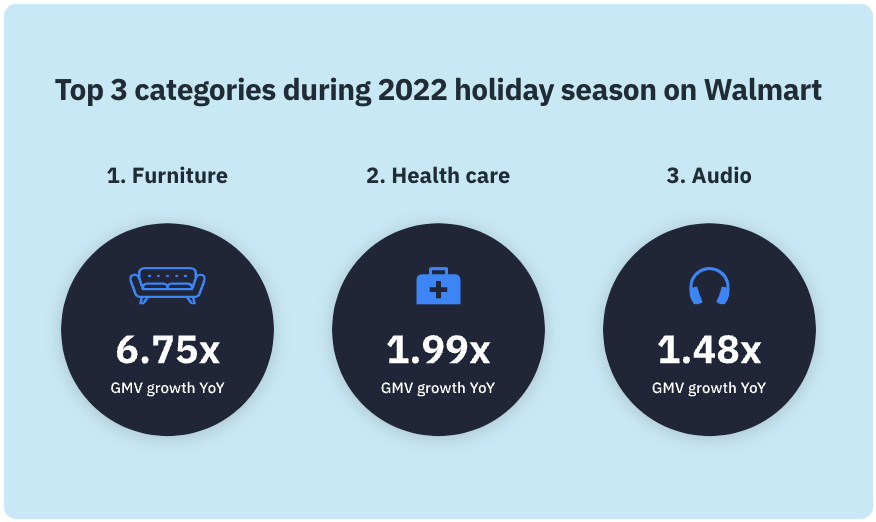The peak season growth playbook 2023
The Peak Season Growth Playbook
Learn how to maximize revenue this year with inventory, fulfillment and paid media tactics, based on Linnworks research and interviews with 16 ecommerce experts
Thank you to everyone who contributed, including Walmart, ShipBob, ShipStation, FordeBaker, Marketplace AMP, LightSpeed and Tambo.

In the fast-paced, boundary-pushing world of ecommerce, being in the right place at the right time is not just about taking opportunities – it’s about creating them.
This notion rings especially true during peak season, and it’s where omnichannel comes into play.
Did you know: over the 2022 holiday season (November 1 to December 31), consumers in the US alone spent $211.7 billion online, a 3.5% growth year-on-year.
Every ecommerce player knows how huge an opportunity peak season is, if done right. But how and where does omnichannel come into play? And what exactly is it?
It’s a term that has been echoing throughout boardrooms and conferences, often misunderstood, and frequently underestimated.
Omnichannel isn’t just about creating a smooth, uninterrupted front-end experience across websites, marketplaces, and brick-and-mortar stores. No, that’s just the tip of the iceberg.
While this high-quality frictionless customer experience is key all year round, it’s pivotal to reaping the rewards that peak offers.
True omnichannel extends deep beneath the surface – it’s about bringing your backend operations and supply chain management into the fold to paint the bigger picture.
It’s about integrating your warehouse operations, inventory, and order management into a streamlined, well-oiled machine that’s ready to deliver peak performance during peak season.
Now, you might be wondering…
How do you use an omnichannel strategy to achieve peak growth?
How do you synchronize these moving parts into a harmonic dance of efficiency and effectiveness?
That’s why we’ve spoken with some 16 ecommerce experts. We’ve picked the brains of the innovators at Lightspeed and ShipBob, exchanged insights with the experts at Walmart, and delved into the operational wisdom of Purple Fire, amongst many others.
Our conversations have helped paint a holistic, no-holds-barred view of how an omnichannel strategy can supercharge your business during peak season. 👇
3 ecommerce trends that will drive growth in 2023 and beyond
Before we dive into the specific tactics that ecommerce businesses can adopt for peak growth, let’s take a look at the trends currently reigning.
Staying ahead of trends is crucial for ecommerce success, especially during peak shopping seasons.
Based on a recent Linnworks survey, we’ve identified three commerce trends set to drive growth in 2023 and beyond.
- Multichannel selling is essential to compete
- Simplifying your commerce operation is a must
- Customer experience is a key driver of growth
These trends offer retailers unique opportunities to reach their customers, manage high-demand periods effectively, and ultimately, boost growth using omnichannel strategies.
Let’s take a deep dive and discover the strategic insights that businesses can leverage to win during peak periods.
1) Multichannel selling is essential to compete
The post-pandemic economy calls for more than mere adaptation.
Success will belong to brands who proactively place their products before eager shoppers, instead of passively awaiting discovery.
This is where multichannel selling comes in…

The power of marketplaces
Marketplaces are proving to be the pulse of retail growth, outperforming competitors and growing by an astounding 81% YoY in 2020.
That’s not all – half of all product searches start on Amazon. Marketplaces deliver an unmatched audience across countless categories.
For peak seasons, when customer demand surges, marketplaces not only help manage the influx but also take on the burden of order management with their fulfillment options.
However, it’s important to remember that selling on marketplaces does involve sacrificing some control over brand presentation and customer relationships.
D2C (Direct to Consumer)
In the age of individualized experiences, D2C has been an absolute game-changer.
Retailers now have the chance to build data-driven relationships with customers, allowing them to predict their needs, and cultivate greater brand loyalty.
D2C is especially powerful during peak periods as it enables brands to directly manage the surge in demand, ensuring the customer experience remains top-notch.
A word of caution, however – brands must balance D2C, B2B, and marketplace offerings to prevent pricing conflicts and sustain a harmonious omnichannel customer experience.
The rise of social commerce
With convenience as its mantra, social commerce continues on a trajectory of rapid growth.
In fact, it’s projected to grow at around 28% per year for the next six years. In the throes of the peak season, social commerce can help brands tap into a wealth of impulse purchases.
Instagram and TikTok lead the pack in terms of product discovery and purchases. For brands, social commerce offers an opportunity to meet customers where they are, make the shopping experience as seamless as possible, and ultimately drive growth.
2) Simplifying your commerce operation is a must
Ecommerce operations become increasingly complex during peak shopping seasons.
In these high-demand periods, simplifying your commerce operation is crucial to effectively manage the surge.
Key areas such as shipping, returns, inventory, supply-demand prediction, and warehouse operations demand particular attention.
Here’s how to handle these elements with the peak season in mind…
1) Manage the shipping process
Peak seasons are challenging due to the surge in order volumes.
Implement automated shipping processes to minimize labor intensity and errors.
Automation can streamline fulfillment from various warehouses, consolidate orders, and select optimal delivery partners, resulting in a more efficient operation crucial for coping with holiday demands.
2) Handle returns fairly
Returns surge during peak shopping periods.
More orders = more returns – it’s simple math, really.
Transparent, hassle-free return processes can increase customer loyalty and secure future sales. Around 72% of customers value clear return policies when shopping, particularly during peak seasons.
Design a fair, easy return process to maintain customer satisfaction during the busiest shopping times.
3) Stay on top of inventory
The holiday season really puts inventory management to the test.
Automation can facilitate prompt order fulfillment by ensuring accurate stock ordering – a necessity in peak shopping times.
Not only does it maintain real-time inventory across warehouses and triggers timely reordering but it can also place orders with suppliers, reduce manual errors, prevent stockouts, and ensures readiness for the holiday rush.
4) Predict supply and demand
Intelligent software that accurately predicts sales patterns is invaluable for planning stock levels during peak seasons.
Automating restocking triggers and purchase orders helps handle the holiday sales surge, minimizing errors, saving costs, and maintaining positive supplier relationships.
5) Optimize warehouse management operations
Peak periods demand efficient warehouse management to fulfill increasing sales.
Automation aids in fulfilling orders from multiple warehouses, and identifies and resolves bottlenecks that can cause delivery delays during high-demand times.
You can enhance productivity, lowers costs, and helps maintain delivery promises, ensuring your business stays on top during peak shopping periods.
3) Customer experience is a key driver of growth
As the rise of ecommerce has created an always-on shopping environment, customer experience has emerged as a key driver of growth, particularly during peak shopping periods.
You can tackle the customer experience beast by…
1) Keeping pace with customer expectations
The shopping journey is fragmented across numerous channels in today’s digital landscape.
Recent Dentsu research highlights the challenge: while shopping journeys now feature 7.6 touchpoints with a retailer, 90% of ecommerce marketers find it difficult to connect three or more channels.
This means that providing a seamless, interconnected shopping experience is more crucial than ever.
2) Offering a personalized experience
Tailoring the shopping experience to individual preferences can be a significant boom for business.
Personalization isn’t a new thing, it’s been a buzzword for a few years now.
However, recent changes – largely accelerated by the pandemic – show that 97% of American shoppers have abandoned online purchases due to a lack of convenience.
This makes it abundantly clear that reducing friction at every step of the customer journey is key to retaining customers and promoting growth.
Personalization is one way you can provide the tailored experience consumers have come to expect, with all the little touches and none of the friction.
Talking about friction…

3) Provide a frictionless checkout and delivery process
The customer expectation for a seamless experience extends to checkout and delivery.
Consumers expect options like guest checkouts, multiple delivery choices, and click-and-collect services.
Research shows that 61% of users are willing to wait longer for free delivery, and 43% expect a click-and-collect option. Catering to these preferences can lead to increased customer satisfaction and loyalty.
4) Address potential sustainability concerns
In today’s market, the customer experience isn’t confined to the purchase alone. It’s also about how businesses operate.
PwC’s research highlights that 50% of consumers are making more eco-friendly shopping decisions, showing a clear desire to support businesses that share their values.
Authenticity and transparency around business practices and sustainability initiatives can help businesses resonate with customers, boosting their reputation and fostering trust.
Now we’ve covered a few of the key trends for the 2023 peak season, let’s take a look at some of the tactics ecommerce businesses can adopt do drive peak growth.
Peak playbook: Leverage these 16 tactics to drive revenue and growth
So, you want to drive revenue and growth during the peak season?
Well, you’ve come to the right place.
Let’s dive into the insights from the experts…
When it comes to peak, preparation is king
Ready to uncover the power of strategic planning, the significance of using historical data, the art of effective inventory management, and the importance of a well-orchestrated return analysis?
It might sound like a mouthful but it’s easier done than said!
Each element provides a cog in the wheel of a successful peak season.
This is a treasure trove of insights that helps you turn forethought into your secret weapon and empower you to rule the peak season with confidence and authority.
Remember, when the peak season rush arrives, it’s the prepared minds that reign supreme!
1) Prepare ahead of time
What’s the tip?
As the peak season approaches, retailers must proactively plan their campaigns for key shopping events such as Thanksgiving, Black Friday, Holiday Season, and New Year.
This preparation should include finalizing artwork, most of the content, and appropriate stock, especially considering the nature of your business.
Smooth transitions between key points can significantly reduce stress during these high-demand periods.
Who said this?
Joe Bowab, Founder & CEO of Lobster Anywhere.
How do I implement?
- Prepare – begin planning well in advance of the peak shopping period. List out all key dates and determine the specific campaigns, deals, sales, or discounts you’ll offer on each of these days
- Create content – design your marketing content, including artwork and copy, well before the season begins. This allows time for revisions and approvals without the last-minute rush
- Manage stock – align your stock preparation with the planned campaigns. If you’re in a seasonal business like seafood, understand what will be in season and plan accordingly. Always have backup plans in case things don’t go as planned.
- Be flexible – while it’s crucial to prepare as much as possible in advance, leave room for minor changes that might be required based on real-time customer responses or market trends
2) Make the most out of historical ad data
What’s the tip?
Brands that excel during the Q4 peak and beyond are those leveraging their current and historical advertising data to inform strategy and optimizations.
With platforms like Amazon Marketing Cloud (AMC), brands can harness the power of custom audiences, the path to purchase, NTB (New-to-Brand) metrics, and more.
Who said this?
Jennifer Hodgkinson, Managing Partner at Tambo.
How do I implement?
- Conduct data analysis – begin by collecting and examining your current and historical advertising data. Identify trends, successful strategies, and areas for improvement
- Leverage tools – use tools like AMC to gain deeper insights into your audience and their buying behavior. Focus on metrics like the path to purchase and NTB to understand customer journeys better
- Strategize – use the insights from your data analysis to inform your marketing strategies. Create campaigns targeting custom audiences identified through the data and tailor your approach based on their past interactions with your brand
- Optimize – regularly review your strategies based on ongoing data and adjust your campaigns accordingly for maximum effectiveness
3) Implement a return analysis to identify recurring issues
What’s the tip?
Peak season inevitably leads to increased returns.
To handle this effectively and avoid customer dissatisfaction, it’s crucial to prepare in advance.
Implement a return analysis plan to identify recurring issues and make necessary adjustments for future peak seasons.
Who said this?
Zach Dannett, Co-Founder of Tumble.
How do I implement?
- Leverage forecasting – use historical data and sales projections to anticipate the volume of returns after the holiday shopping season
- Allocate resources – allocate sufficient human resources to handle the anticipated influx of returns
- Adopt return analysis – implement a return analysis plan to identify common issues leading to returns
- Take action – use the insights gained from your return analysis to make necessary adjustments, enhancing your product or service to reduce return volumes in future peak seasons
Note: Linnworks makes returns super easy. No more locating returned orders on individual marketplaces, registering the return, manually adding that stock back into your inventory, and then ensuring the stock is correct on other channels.
You can do all of this within the Linnworks platform, saving time and creating greater efficiencies.
4) Make sure your inventory management processes are optimized
What’s the tip?
Optimize your inventory management processes ahead of peak season.
Analyze previous sales data to forecast demand, identify popular products, and estimate the required stock levels.
Ensure a diverse range of payment methods and enhance the shopping experience if you have a physical store.
Who said this?
Jackson Versitano, Regional Manager UK, IRE and RoMEA at Lightspeed Commerce.
How do I implement?
- Prepare – prepare for your peak season well in advance
- Conduct data analysis – analyze past sales data and trends to predict demand, identify popular products, and estimate necessary stock quantities
- Manage inventory – optimize your inventory management practices. Utilize systems like just-in-time inventory or drop shipping to avoid overstocking or running out of stock
- Review store atmosphere – if applicable, create an engaging, visually pleasing store environment. Consider additional services like gift wrapping or personal shopping assistance
- Consider payment options – offer a wide variety of payment methods including credit/debit cards, mobile wallets, gift cards, and online payment platforms to ensure convenience for customers
Note: As a G2 leader in inventory management, Linnworks takes inventory management to a whole new level. The platform enables you to optimize inventory and order management, all while simplifying the entire process by offering an all-in-one solution that’s tailored to your business needs.
Survive the seasonal surge with optimized fulfillment
Prepare to confidently navigate the wave of the seasonal surge with this next section.
Learn how to streamline your logistics, speed up deliveries, and keep shipping costs in check without compromising on customer satisfaction.
5) Implement a strategic holiday fulfillment gameplan
What’s the tip?
Implement a strategic holiday fulfillment game plan.
Consider partnering with a scalable 3PL (Third-Party Logistics) to meet demand and deliver orders quickly and economically.
Leverage strategies like storing products in multiple warehouses and offering free and fast shipping. Create a shipping calendar and clearly communicate order deadlines with your customers.
Who said this?
Kristina Lopienski, Director of Content Marketing at ShipBob.
How do I implement?
- Reevaluate your fulfillment strategy – consider partnering with a scalable third-party logistics provider (3PL) to manage increased demand efficiently.
- Leverage multiple warehouses – store your products in more than one warehouse across various regions or even countries. This can reduce shipping costs and transit times
- Create a detailed shipping calendar – include cutoff dates and clearly communicate these deadlines to your customers
- Offer free & fast shipping – experiment with free and fast shipping options. Test different free shipping thresholds above your AOV (Average Order Value) to see what resonates with your customers
- Show delivery dates & badges – clearly display estimated delivery dates and fast shipping badges on product pages to inform customers of pre-checkout
6) Diversify shipping options to save on shipping costs
What’s the tip?
Diversify shipping options to save on costs.
Many consumers are willing to swap faster deliveries for savings.
Communicate clearly about shipping costs and timings to maintain conversion rates. Utilize slower, less costly services and tech stack automation to improve operation efficiency.
Who said this?
Krish Iyer, VP of Industry Relations and Partnerships at ShipStation.

How do I implement?
- Provide transparent communication – clearly communicate shipping costs and timing to avoid surprises that could affect conversion rates
- Offer diverse carrier options – diversify your carrier and service choices. Consider slower, less expensive services that still meet the delivery promises made at checkout
- Leverage discounts – with services like ShipStation, access discounts for a range of shipping services to further reduce costs
- Improve operational efficiency – improve your operations with the right tech stack and automation. This enables faster fulfillment lag time, allowing for more leniency in carrier transit time without impacting delivery promises
- Review consumer expectations – remember, most customers are willing to wait 3-7 days for their packages. Use this to your advantage when choosing your shipping options
Note: SkuVault enables you to easily sync your warehouse data to a single platform, making managing stock from multiple warehouses quick and easy. SkuVault is also a Shipstation partner, which means you can integrate with their fulfillment platform to enable your business to grow at scale.
Make your ads add up
Unlock the true potential of your advertising campaigns. Here, we delve into an arsenal of innovative strategies – formulated by industry experts – that can help you command the peak season.
Learn how to orchestrate your ad spend, monetize your popularity, and rapidly accelerate your revenue growth.
7) Lower prices in September to boost visibility during peak
What’s the tip?
For ecommerce businesses, particularly those on Amazon, a trading strategy that balances margin, price, and organic visibility can be crucial.
Lowering prices early on during peak season can increase sales velocity and organic visibility, preparing for increased revenue during the main peak period.
Who said this?
Tom Baker, Director at FordeBaker.
How do I implement?
- Lower prices early – in the initial months of September and October, decrease your prices to encourage as many sales as possible. This increased sales velocity can boost your organic visibility
- Balance margin and visibility – understand that while you’re sacrificing margin with lower prices, the actual decrease in revenue should be minimal due to lower sales volumes in these months
- Plan for the later peak period – aim to boost visibility for the later peak period. By then, your prices should be back to normal (before Black Friday, so any discounts are from your list prices), allowing you to benefit from the enhanced visibility you established in the earlier months

8) Use additional revenue to offer discounts
What’s the tip?
Use the extra revenue generated during peak season to offer discounts and rewards to your customers.
This not only drives sales but also enhances customer loyalty and brand appreciation.
Who said this?
Ariav Cohen, VP of Marketing and Sales at Proprep.
How do I implement?
- Project your revenue – project your peak season revenue and identify portions that can be used for customer discounts or cashback offers
- Plan your offers – design and communicate these promotions in a way that expresses gratitude for your customer’s loyalty
- Spread the word – word about discounts and freebies spreads faster than usual, so make sure your marketing team is geared up to handle the increased attention.
9) Bleed ad dollars…fast
What’s the tip?
Speed up your ad spend to gather useful data swiftly.
Focus on NTB customers and optimize your main image for mobile to enhance CTR (Click Through Rates).
Who said this?
The team at Marketplace AMP.
How do I implement?
- Adopt fast expenditure – increase your ad spend quickly to gather as much data as possible for swift learning
- Focus on NTB – create compelling offers to entice NTB customers. Utilize detailed competitor analysis to craft these deals and gather reviews that can boost conversion
- Optimize for mobile – with most users accessing online platforms via mobile, optimize your main image for this format to maximize click-through rates
10) Use paid ads to promote already popular products
What’s the tip?
During the peak season, utilize paid ads to promote your most popular products.
This strategy not only caters to existing customer preferences but also has the potential to attract new market segments.
Additionally, it’s beneficial to stir up a sense of urgency through time-sensitive offers.
Who said this?
Sarah Jameson, Marketing Director at Green Building Elements.
How do I implement?
- Identify your best-sellers – understand your market and identify the products that have performed exceptionally well in the past or have high customer interest
- Leverage paid ads – use paid advertising to promote these products. Also, consider enhancing these ads with engaging marketing assets such as videos or high-quality graphics
- Create a sense of urgency – develop limited-time promotions and deals for the peak season. Use marketing tools like countdown timers, stock availability alerts, and exclusive time-bound discounts to encourage prompt purchases
- Ensure clear communication – ensure the time-sensitive nature of these promotions is clearly communicated through your marketing channels to create effective urgency
11) Optimize your sponsored search campaigns
What’s the tip?
Based on Walmart’s top-selling categories during the 2022 holiday season, optimizing sponsored search campaigns can significantly improve performance.
It’s also key to prepare top-performing items in your catalog with best-of-web pricing for key seasonal events.
Who said this?
The team at Walmart.
How do I implement?
- Know the trends – understand the top-performing categories during the holiday season. For instance, in 2022, these were furniture, health care, and audio at Walmart
- Optimize your listings – ensure your product listings are optimized for these categories. Prepare your top-performing items with competitive pricing for key seasonal events
- Plan your inventory – make sure your inventory is well-stocked to meet the high demand during the peak season. Timely replenish your inventory at Walmart Fulfillment Centers as needed, if you use one
- Optimize sponsored search campaigns – drive conversion by optimizing your sponsored search campaigns. Sellers who did so on Black Friday saw, on average, a 61% increase in ROAS (Return on Ad Spend) and conversion

Focus on the customer experience to peak curiosity
Let’s explore some of the strategies from industry experts on how enhancing the customer experience increases engagement and revenue during the peak season.
From simplifying checkout processes to leveraging real-time data for decision-making and making the customer experience the top priority, this section provides insightful tips for ecommerce businesses looking to optimize their operations.
12) Simplify the checkout experience as much as possible
What’s the tip?
Simplifying the checkout experience can prevent higher cart abandonment rates during peak seasons.
This includes easy social signups and offering multiple popular payment methods.
Who said this?
Tony Angeleri, VP of Business Development at Lone Wolf Paintball.
How do I implement?
- Provide easy social signups – minimize the hassle of signups by providing social media-linked logins, such as Instagram, Facebook, and Twitter. It eliminates the need for remembering yet another password
- Offer multiple payment methods – offer flexibility and convenience by supporting various popular payment methods. Highlight options that offer added discounts or cashback to incentivize purchases
- Streamline the checkout process – ensure your checkout process is simple, quick, and user-friendly to avoid cart abandonment during high-traffic times
Note: Did you know that Shopify checkouts convert on average 15% better than the competition? That’s why both Linnworks and SkuVault easily integrate with Shopify, and you can get set up in just a few clicks.
13) Use real-time customer data to make better decisions
What’s the tip?
Utilize real-time data to understand consumer trends, manage inventory, refine marketing efforts, and even predict upcoming trends.
This can enhance customer satisfaction and boost revenues.
Who said this?
Ryan McKenzie, Co-founder & CMO at Tru Earth.
How do I implement?
- Use real-time data analysis – employ modern software solutions to track customer interactions and behavior, providing insights for informed decision-making
- Leverage inventory management – using past and real-time shopping trends, prepare for sudden spikes in demand, ensuring popular items remain in stock during high-traffic periods
- Refine marketing strategies – use sales and customer behavior data to identify successful marketing strategies and implement these during peak seasons for better targeting
- Integrate with AI systems – use AI systems to predict upcoming trends, expected demand, conversion rates, and marketing effectiveness, aiding in preparations for peak seasons
Note: Linnworks and SkuVault both provide real-time inventory data that can be synced across all sales channels into a single dashboard, providing greater visibility over your customer data. See them in action here – Linnworks demo | SkuVault demo.
14) Make the customer experience your #1 priority
What’s the tip?
Start preparations early and make customer experience your top priority.
This involves marketing, website preparedness, supply chain management, and clear communication of policies.
Who said this?
Daniel Chabert, CEO & Founder of Purple Fire.
How do I implement?
- Conduct early marketing preparations – develop and schedule holiday-themed email campaigns or social media posts in advance. Use data from previous buying patterns to create targeted campaigns and retargeting strategies
- Get your website ready – test your website’s capacity to handle increased traffic during peak season to avoid potential failures
- Overestimate product needs – anticipate high demand and prepare your supply chain accordingly to prevent running out of stock during peak sales times
- Clearly communicate policies – ensure your policies regarding shipping, returns, and customer service are clearly communicated and designed to meet customer needs. This can create a positive customer experience, leading to long-term customer loyalty.
Bonus section
As a special add-on to our peak season guide, we’ve included a bonus section – lucky you!
Here, we delve into strategic considerations for employee vacation planning and essential aspects of nailing product launches.
15) Optimize employee vacation time during peak season
What’s the tip?
Manage employee vacations efficiently during peak season to avoid overlapping absences.
Simultaneous absences could slow down internal processes and potentially lead to negative customer experiences.
Who said this?
Joshua Host, Founder at ThriveLab.
How do I implement?
- Coordinate your team – work within your team to plan vacations and ensure there’s always sufficient coverage to maintain smooth operations
- Manage employee vacations – while it’s crucial for employees to have their well-deserved breaks, try to manage the timing in a way that benefits both the team and customers
16) Nail your product launches
What’s the tip?
A solid strategy to boost revenue during peak season is to focus on executing successful product launches.
This involves creating compelling product listings, applying robust SEO, employing full-funnel advertising, and ensuring sufficient inventory.
Who said this?
Liz Tyler, Operations Director at Marketplace AMP (again)!
How do I implement?
- Develop attention-grabbing product imagery and copy – prior to launching, ensure your product listings are retail-ready with compelling images and copy that would attract potential buyers and boost conversion
- Use SEO and full-funnel advertising – enhance discoverability in search results by employing robust SEO on product listings and amplifying your reach through full-funnel advertising
- Leverage well-timed promotions – alongside marketing efforts, consider offering promotions at strategic times to draw in more customers
- Manage inventory – ensure your inventory is fully stocked to avoid running out of items during peak sales time and missing out on potential sales
Phew – that’s a lot of tactics!
Stay tuned – we’ve got more peak tips to come
As we wrap up our journey through this playbook, it’s clear that the heart of a thriving peak season lies in strategic planning, precise execution, and a strong customer-centric approach.
By embracing these strategies, businesses can arm themselves with the tools to not just survive but excel during the peak season.
If you’re keen to see how our platform can supercharge your business operations, why not take Linnworks or SkuVault for a test drive? It’s your chance to peek under the hood and experience firsthand how the platforms work.